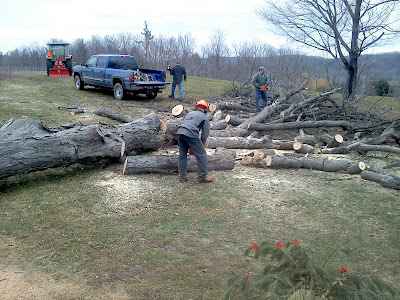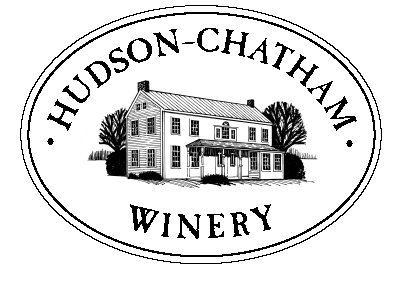THE BIG TREE

There is always something wrong with cutting down a tree. Especially a big one. Recently, we had no choice. The shaggy hickory in front of the winery was already half dead, and as hurricane season is coming up on top of us, our worst fear was that the dying tree might lose one of its mighty limbs right on the roof, or even worse yet, the coupla of our tastinging room, over which the tree's incredible limbs constantly hovered.
 The Northern Shagbark Hickory - The main range of shagbark hickory (Carya ovata) ends just north of the St. Lawrence River in eastern North America, zone 5b. Hickory wood is very hard, very stiff, very dense and very shock resistant. As stated in the U.S. Forestry Service pamphlet on "Important Trees of Eastern Forests", "there are some woods that are stronger than hickory and some that are harder, but the combination of strength, toughness, hardness, and stiffness found in hickory wood is not found in any other commercial wood."[6] It is used for tool handles, bows, wheel spokes, carts, drumsticks, lacrosse stick handles, golf club shafts (sometimes still called hickory stick, even though made of steel or graphite), the bottom of skis, walking sticks and for punitive use as a switch (like hazel), and especially as a cane-like hickory stick in schools and use by parents. Paddles are often made from hickory. Baseball bats were formerly made of hickory, but are now more commonly made of ash. Hickory is replacing ash as the wood of choice for Scottish shinty sticks (also known as camans).
The Northern Shagbark Hickory - The main range of shagbark hickory (Carya ovata) ends just north of the St. Lawrence River in eastern North America, zone 5b. Hickory wood is very hard, very stiff, very dense and very shock resistant. As stated in the U.S. Forestry Service pamphlet on "Important Trees of Eastern Forests", "there are some woods that are stronger than hickory and some that are harder, but the combination of strength, toughness, hardness, and stiffness found in hickory wood is not found in any other commercial wood."[6] It is used for tool handles, bows, wheel spokes, carts, drumsticks, lacrosse stick handles, golf club shafts (sometimes still called hickory stick, even though made of steel or graphite), the bottom of skis, walking sticks and for punitive use as a switch (like hazel), and especially as a cane-like hickory stick in schools and use by parents. Paddles are often made from hickory. Baseball bats were formerly made of hickory, but are now more commonly made of ash. Hickory is replacing ash as the wood of choice for Scottish shinty sticks (also known as camans). 
Hickory is also highly prized for wood-burning stoves, because of its high energy content. Hickory wood is also a preferred type for smoke curing meats. In the Southern United States, hickory is popular for cooking barbecue, as hickory grows abundantly in the region, and adds flavor to the meat. Hickory is sometimes used for wood flooring due to its durability and character.


There is always something wrong with cutting down a tree. Especially a big one. Recently, we had no choice. The shaggy hickory in front of the winery was already half dead, and as hurricane season is coming up on top of us, our worst fear was that the dying tree might lose one of its mighty limbs right on the roof, or even worse yet, the coupla of our tastinging room, over which the tree's incredible limbs constantly hovered.
 The Northern Shagbark Hickory - The main range of shagbark hickory (Carya ovata) ends just north of the St. Lawrence River in eastern North America, zone 5b. Hickory wood is very hard, very stiff, very dense and very shock resistant. As stated in the U.S. Forestry Service pamphlet on "Important Trees of Eastern Forests", "there are some woods that are stronger than hickory and some that are harder, but the combination of strength, toughness, hardness, and stiffness found in hickory wood is not found in any other commercial wood."[6] It is used for tool handles, bows, wheel spokes, carts, drumsticks, lacrosse stick handles, golf club shafts (sometimes still called hickory stick, even though made of steel or graphite), the bottom of skis, walking sticks and for punitive use as a switch (like hazel), and especially as a cane-like hickory stick in schools and use by parents. Paddles are often made from hickory. Baseball bats were formerly made of hickory, but are now more commonly made of ash. Hickory is replacing ash as the wood of choice for Scottish shinty sticks (also known as camans).
The Northern Shagbark Hickory - The main range of shagbark hickory (Carya ovata) ends just north of the St. Lawrence River in eastern North America, zone 5b. Hickory wood is very hard, very stiff, very dense and very shock resistant. As stated in the U.S. Forestry Service pamphlet on "Important Trees of Eastern Forests", "there are some woods that are stronger than hickory and some that are harder, but the combination of strength, toughness, hardness, and stiffness found in hickory wood is not found in any other commercial wood."[6] It is used for tool handles, bows, wheel spokes, carts, drumsticks, lacrosse stick handles, golf club shafts (sometimes still called hickory stick, even though made of steel or graphite), the bottom of skis, walking sticks and for punitive use as a switch (like hazel), and especially as a cane-like hickory stick in schools and use by parents. Paddles are often made from hickory. Baseball bats were formerly made of hickory, but are now more commonly made of ash. Hickory is replacing ash as the wood of choice for Scottish shinty sticks (also known as camans).
Hickory is also highly prized for wood-burning stoves, because of its high energy content. Hickory wood is also a preferred type for smoke curing meats. In the Southern United States, hickory is popular for cooking barbecue, as hickory grows abundantly in the region, and adds flavor to the meat. Hickory is sometimes used for wood flooring due to its durability and character.

A bark extract from shagbark hickory is also used in an edible syrup similar to maple syrup, with a slightly bitter, smoky taste.
The nuts of some species are palatable, while others are bitter and only suitable for animal feed. Shagbark and shellbark hickory, along with pecan, are regarded by some as the finest nut trees.
Ralph and Craig and friends came over and felled he tree in a few minutes, and then within hours thwo-thirds of the tree were loaded onto a truck and shipped off to a wood furnace used to heat a shop down the road.
Hard to beieve a tree that stretched more than 100 feet high, and whose trunk had to weigh a good 4-5 tons was gone within 24 hours, with little evidence of it to show but a wide, low stump.





0 Comments:
Post a Comment
<< Home